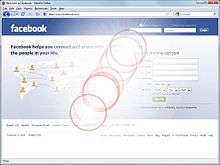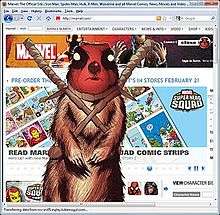Konami Code


The Konami Code (Japanese: コナミコマンド, Konami komando, "Konami command") is a cheat code that appears in many Konami video games,[1] although the code also appears in some non-Konami games.[2]
During the title screen before the game demo begins, the player could press the following sequence of buttons on the game controller to enable the cheat:
↑↑↓↓←→←→BA
The code has also found a place in popular culture as a reference to the third generation of video game consoles.[3] The code is also present as an Easter egg on a number of websites.[4][5][6][7][8]
History
The code was first used in the 1986 release of Gradius for the NES[9] and was popularized among North American players in the NES version of Contra, for which it was also dubbed both the "Contra Code" and "30 Lives Code".
The Konami Code was created by Kazuhisa Hashimoto, who was developing the home port of the 1985 arcade game Gradius, a scrolling shooter released on the NES in 1986. Finding the game too difficult to play through during testing, he created a cheat code to give the player a full set of power-ups (normally attained gradually throughout the game).[2] The code was still present in the released Gradius after Hashimoto forgot to remove it. Players discovered and shared the code via word of mouth.
The Konami Code was thus included in the series' other sequels and spin-offs, with some key differences:
- In the Super NES version of Gradius III, the original code destroys the player's ship. However, replacing ← and → with the L and R triggers of the SNES controller powers up the ship.
- In the most recent iteration of the series—Gradius Rebirth on the Wii—the Wii Remote's 1 and 2 buttons fill in for A and B, respectively.
The code has been subsequently re-used in a large number of other games and a varied version of the code is now used in the Opera Browser to activate hidden advanced settings.[10]
Variations
The original version of the cheat code was designed for the NES controller. The exact sequence varies from game to game and has been adapted to fit the button layouts of different video game consoles, mostly the A and B buttons. For example:
- Any code for a PlayStation controller, which uses shapes instead of letters, would use "×, ○", appearing even in Konami's Dance Dance Revolution series, input on the dance pad.
- In mobile phone games by Konami, they are replaced by 5 7 3 on the numerical pad, which is the goroawase pronunciation for "konami"; 5 is pronounced go, 7 can be pronounced nana or just na for short, and the kanji for 3, 三, looks very much like the katakana (sound alphabet) sign for mi, namely ミ. Together, this becomes go-na-mi.
- 573 is also used extensively in the Dance Dance Revolution series; the original board for DDR 1stMIX (also used in many other Konami designs) was called System 573, the maximum combo in several difficult songs (such as MAX 300) is 573, highscores often start out at 573 000 or similar, and so on.
These deviations may occur:
- for purely operational reasons (e.g., if the code must be entered while the game is paused, the code might be altered to avoid hitting the unpause button),
- to keep powerful upgrades better concealed while still referencing Konami, or
- through an error in writing the code in the game.
Curiously, the "B" and "A" buttons were switched for the code when used in the 1991 NES game Teenage Mutant Ninja Turtles III: The Manhattan Project.[11]
Despite the differences, though, these codes are still often referred to in general discussion as "Konami Code", "Conami Kode", or, less commonly, "Pseudo-Konami Code".
A common misconception is that the code ends with Start or Select Start. In many titles, the player must press Start after entering the code in order to start a game, or press Select to switch to two-player mode and then start the game, leading to the confusion.
See also
References
- ↑ The editors of GamePro and GamerHelp.com, "The 'Contra Code:' We Must Never Forget," GamePro 235 (April 2008): 63.
- 1 2 "Cracking the Code: The Konami Code". 1up.com. Retrieved 2008-03-15.
- ↑ Robinson, Tasha (November 1, 2012). "Wreck-It Ralph". A.V. Club. Retrieved November 19, 2012.
- ↑ Carvin, Andy (June 14, 2010). "Geek Trick Of The Week: Newsweek Vs. The Zombies.". NPR. Retrieved June 14, 2010.
- ↑ "The Konami Code Makes ESPN.com Magical!". Kotaku.
- ↑ "Konami Code triggers Easter egg on Facebook too". CNET. 2009-05-08.
- ↑ Moore, Matthew (September 17, 2009). "Google easter eggs: 15 best hidden jokes". The Daily Telegraph. London.
- ↑ "Alan Turing Google Doodle Source Code". Google. 2012-07-02.
- ↑ "Geek Trivia: The cheat goes on". techrepublic.com. Retrieved 2008-04-16.
- ↑ http://techdows.com/2014/06/use-konami-code-to-enable-power-user-settings-in-opera.html
- ↑ http://www.gamefaqs.com/nes/563469-teenage-mutant-ninja-turtles-iii-the-manhattan/cheats
External links
- Video about the Konami Code from the G4 TV show Cheat!
- List of websites with special responses to the code
- Another website listing websites with special responses to the code